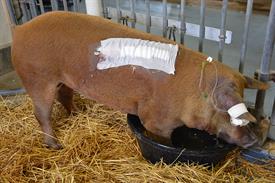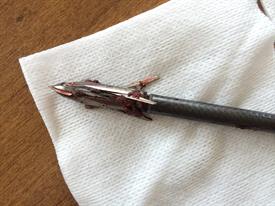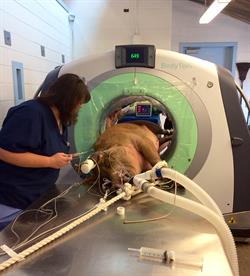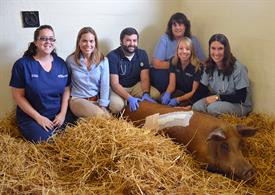Veterinarians at Penn Vet’s New Bolton Center performed emergency surgery on a 500-pound pig found at a Chester County animal sanctuary with a hunting arrow embedded in its chest.
 The five-year-old pig, named Bette, went through an advanced diagnostic evaluation to determine the extent of injury before a two-hour surgery on Wednesday, October 1. Dr. Marie-Eve Fecteau, Assistant Professor of Food Animal Medicine and Surgery at New Bolton Center, removed the metal arrowhead from the right side of Bette’s upper chest and repaired a second arrow wound on the left side of her belly.
The five-year-old pig, named Bette, went through an advanced diagnostic evaluation to determine the extent of injury before a two-hour surgery on Wednesday, October 1. Dr. Marie-Eve Fecteau, Assistant Professor of Food Animal Medicine and Surgery at New Bolton Center, removed the metal arrowhead from the right side of Bette’s upper chest and repaired a second arrow wound on the left side of her belly.
The surgery and subsequent treatment saved her life. Bette recovered well during her week's stay at New Bolton Center, treated with antibiotics and pain medications. The Duroc pig, a breed characterized by its reddish color, returned to her home at an animal sanctuary on Wednesday, October 8.
“I think her prognosis from now on is excellent,” Dr. Fecteau said.
Bette has spent most of her life at the non-profit Chenoa Manor animal sanctuary in Avondale, PA, since she was rescued as an abandoned piglet. "We would like to extend our utmost appreciation to Dr. Marie-Eve Fecteau and her fine team, for the compassion and excellent medical care given to Bette over the past week," Chenoa Manor said on social media.
Executive Director Dr. Robert Teti, a veterinarian, found Bette with the arrow in her side at dinnertime.
 “I called her and she came over and I saw the arrow,” Dr. Teti said, a very surprising discovery, because no animal at the sanctuary had previously been injured by an arrow. About 230 animals of many species live there, including six pigs.
“I called her and she came over and I saw the arrow,” Dr. Teti said, a very surprising discovery, because no animal at the sanctuary had previously been injured by an arrow. About 230 animals of many species live there, including six pigs.
Dr. Teti called New Bolton Center's Field Service, and Dr. Curtis Beidel came to help load Bette on a trailer to transport her to the hospital.
The New Bolton Center team used a unique CT scanner from Neuroligica to evaluate Bette before surgery. Now in a month-long test period at New Bolton Center, the “computed tomography” scanner enables diagnostic evaluation of animals that previously could not be accomplished.
 The scanner provides three-dimensional computer images, which were important in this case, Dr. Fecteau said. In fact, the scans made it possible to avoid opening the pig’s abdomen to assess the extent of her injuries.
The scanner provides three-dimensional computer images, which were important in this case, Dr. Fecteau said. In fact, the scans made it possible to avoid opening the pig’s abdomen to assess the extent of her injuries.
“It was really, really informative,” Dr. Fecteau said. “We could see from the scan that there was no internal damage.”
Usually the veterinarians would have used radiographs, which provide two-dimensional images, but would not have allowed them to investigate fully how far the arrow penetrated the internal organs.
Tissue was protruding from the hole on the pig’s left side, Dr. Fecteau said, but the CT scan showed there was no sign of perforation of the stomach or intestine. As a result, she was able to simply ligate and remove the protruding tissue, and repair that wound.
 The CT scan showed where the arrowhead was lodged in the upper part of the right chest, near the spine. It was clear, however, that the arrowhead did not puncture a lung, and that there was no internal bleeding.
The CT scan showed where the arrowhead was lodged in the upper part of the right chest, near the spine. It was clear, however, that the arrowhead did not puncture a lung, and that there was no internal bleeding.
“The scan showed the exact location of the arrow,” Dr. Fecteau said. “We could see the arrow had fractured the very top of a thoracic vertebra, but the spine itself was intact.”
The arrowhead, about one inch long, was made of several razor-sharp metal pieces. The arrow shaft was about two feet long, but broke off before the pig arrived at New Bolton Center.
Dr. Fecteau performed surgery to remove the arrowhead, as well as clean and repair the wounds. A temporary surgical drain was inserted so fluid from the infection could drain out. The drain was removed three days after surgery, as was the IV catheter. Bette continued on oral antibiotics and pain medication, but she had a great appetite and was quite energetic before she returned to her home at the sanctuary.
"We are so happy that Bette recovered so well, " Dr. Fecteau said.
Dr. Teti called the state police and local law enforcement in an effort to find out who shot the arrows and an anonymous donor offered a reward. The story was covered by local media, and thousands followed the case through posts on social media.